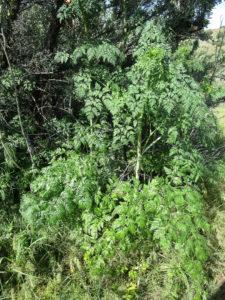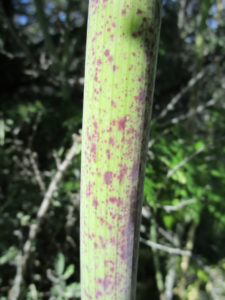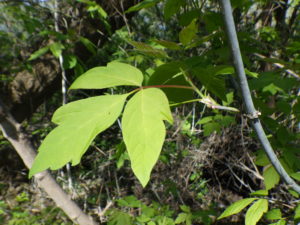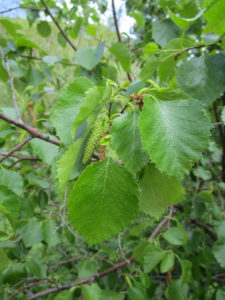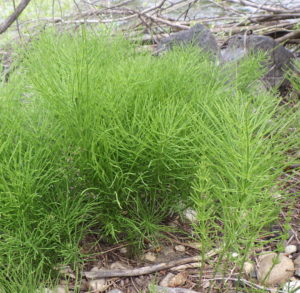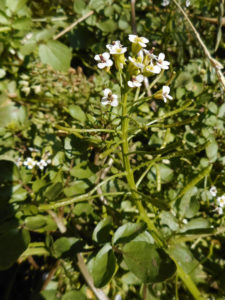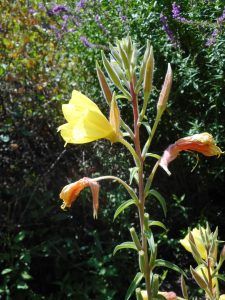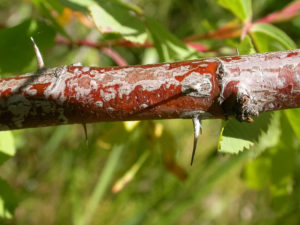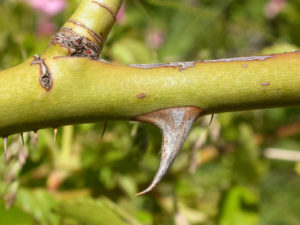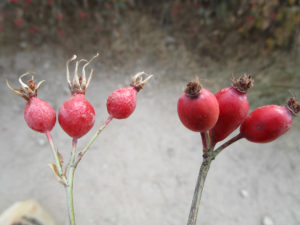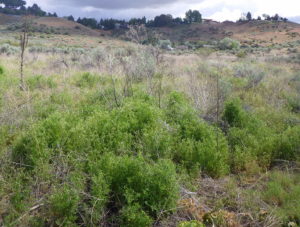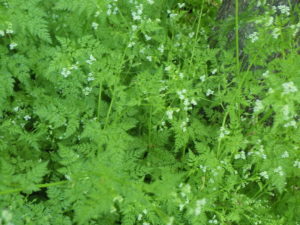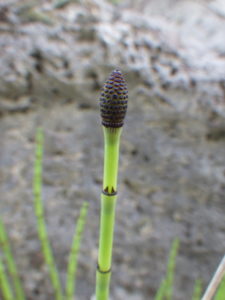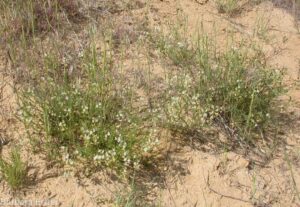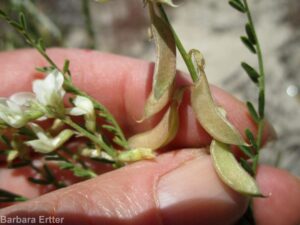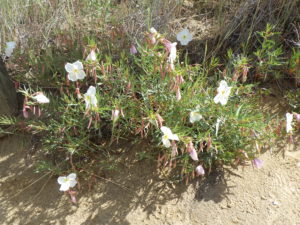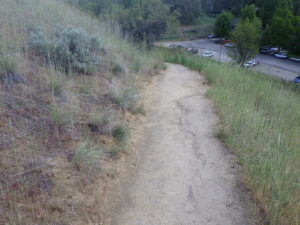CAMEL’S BACK/HULLS GULCH RESERVE WILDFLOWER WALK
mid to late May

Description: This walk explores a diversity of habitats on Camel’s Back and Hull’s Gulch Reserve, showcasing late-spring wildflowers (including Mulford’s milkvetch) and riparian woodland consisting of native and non-native trees and shrubs. The walk begins at the trailhead at the end of 9th Street and is described in a counterclockwise direction. This makes the walk good for an after-dinner hike on a warm day, beginning along the shaded streamside corridor and then ascending the hilltop to catch the sunset. Much of the walk is on pedestrian-only, dog on-leash trails. Total distance is a 1½ mile loop; total elevation gain is about 350 feet.
Hulls Gulch Reserve was one of Boise’s first nature preserves, established in the early 1990s following grassroots efforts that we are now all benefiting from. Although most of the habitat is relatively altered, with an abundance of invasive and other non-native trees, shrubs, grasses, and forbs, enough native wildflowers persist to make this walk worthwhile for plant-lovers. The mixed native/non-native gallery forest is furthermore a significant habitat in its own right, supporting a great diversity of birds and other wildlife.
Soils are mostly fine or coarse sands, representing the sediments eroded from the Idaho Batholith and deposited in ancient Lake Idaho, which came and went between 12 and 2 million years ago. These soils favor rubber rabbitbrush (Ericameria nauseosa, previously in Chrysothamnus) and bitterbrush (Purshia tridentata) as the primary upland shrubs; sagebrush (Artemisia tridentata) is relatively uncommon.
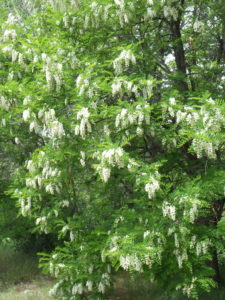
The only native large trees locally are black cottonwood (Populus trichocarpa) and the larger species of willow (Salix). All other large trees that have made themselves at home in Hulls Gulch, and in similar habitats elsewhere in Boise, were introduced by early settlers. As a result, we now walk in the shade of various species of maple (Acer), elm (Ulmus), oak (Quercus), and even catalpa (Catalpa) and mulberry (Morus), when we enjoy our otherwise natural areas. One of the most common is black locust (Robinia pseudoacacia), which forms a conspicuous grove on the hillside next to the 9th Street trailhead and is scattered elsewhere along the walk. Its pinnate leaves and clusters of pealike white flowers tend to appear relatively late, so might not be present at the recommended time for this walk.
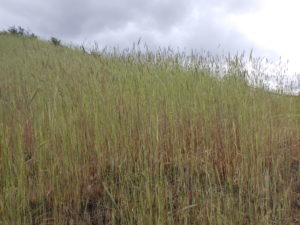
One of the first dominant plants encountered, at the trailhead and throughout the area, is feral or cereal rye (Secale cereale). Locally this highly flammable (when dry) invasive grass is worse than the notorious cheatgrass (Bromus tectorum), which it overtops and crowds out. Feral rye is actively spreading, and given a chance can eventually displace any remaining native species, especially when helped by soil disturbance. Control is difficult, with the best likelihood of success being to quickly remove any pioneering occurrences and to mow established patches after heads develop but before seeds mature. Removing thatch after the seeds have already dropped may reduce the immediate fire hazard for the year, but does nothing to eliminate the infestation.
Begin by walking north on Red Fox Trail #36, taking note of the small dams and resultant ponds that were installed for flood control purposes. If the colony has not been recently sprayed, this is a good opportunity to learn how to recognize the extremely toxic (and notorious) non-native poison-hemlock (Conium maculatum). Even if not in bloom, the fern-like leaves and purple-spotted stem help identify this tall biennial; some people may even notice a characteristic scent given off by the foliage, especially when wet. All parts of the plant, but especially the parsnip-like root, can be deadly to eat; this is the plant that was used to put Socrates to death. Along with willows and wild roses, you may also notice some eastern box-elder (Acer negundo var. violaceum), an unusual maple tree with the leaves divided into three’s. Although there is a native variety of box-elder in southeastern Idaho that has densely and finely hairy branches, all the ones in the Boise area have smooth glaucous (waxy) branches, indicating they were introduced from the eastern US, probably by early settlers.
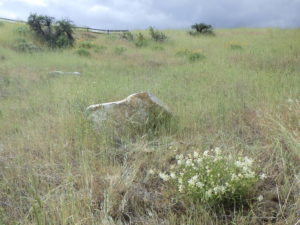
Behind the fence on your left is the restored construction road that allowed heavy equipment to get to the top of Camel’s Back in 2016-2017, for the purpose of preventing erosion that would otherwise have made the popular viewpoint unsafe. A mix of grasses and other plants native to the Boise Foothills were seeded here as rehabilitation, but these were upstaged by the surprise appearance of a few plants of Boise sand-verbena (Abronia mellifera var. pahoveorum), presumably from dormant seeds that had lain buried for an unknown number of years. The Boise sand-verbena, which was described as a distinct variety in 2016, is only found in scattered remnant populations from Lucky Peak Dam to about New Plymouth, and may be sliding to extinction. Evidently it used to be quite common on sandy slopes in the Boise foothills, but the loose open sandy sites it prefers have largely been taken over by non-native annual grasses, or else bulldozed for development. It appears to be a relatively short-lived perennial, with the thick root easily rotting in heavy, wet soils, especially during the winter months. The Camel’s Back reappearance shows the potential longevity of the seeds and adaptations of the plant to freshly disturbed sandy soils. Please do not explore this area except as part of an authorized activity.
Turn right on Hulls Pond Loop (#34), which angles down and then curves back to a bridge crossing the creek. Red-winged blackbirds are conspicuous in the adjacent cattail-filled pond, and can be aggressive during nesting season. Siberian elm (Ulmus pumila) is a common tree along this trail and throughout the area, possibly hybridizing with the less common English elm (Ulmus procera), which has larger, double-toothed leaves. There are also several large black cottonwood (Populus trichocarpa); take note of the wide diversity of leaf shape, even on the same tree. Along the creek before the bridge, there are individuals of two native large shrubs/small trees that are characteristic of local streamsides: the multi-stemmed river birch (Betula occidentalis) on the left, and a mountain or thin-leaf alder (Alnus incana ssp. tenuifolia) on the right. At the bridge itself (and elsewhere on the walk) you can see some common horsetail (Equisetum arvense), a relative of ferns that produces spores in small ephemeral fertile stems before the showier sterile stems expand.
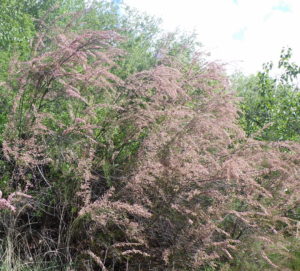
Cross the creek and turn left on Red-Winged Blackbird Trail (#35A). This pedestrian-only trail is a delightful ramble through a diversity of native and non-native shrubs, pleasant even on hot days. One of the first encountered, on the left side of the trail, is a localized patch of small-flowered tamarisk or salt-cedar (Tamarix parviflora). Tamarisk is a major invasive shrub in wetlands of the American West, but is only sporadic in the Boise Front; this patch has nevertheless survived several eradication efforts already. Common native shrubs along the trail include various hard-to-identify willows (Salix), red-osier dogwood (Cornus stolonifera), and interior rose (Rosa woodsii ssp. ultramontana). Among the non-native shrubs are Tatarian honeysuckle (Lonicera tatarica), various plum and cherry relatives (Prunus), European privet (Ligustrum vulgare), Russian-olive (Eleagnus angustifolia), and European cranberry-bush (Viburnum opulus var. opulus). English ivy (Hedera helix) is a potentially invasive ground-cover that has a foothold in a couple of spots along the trail, and Virginia creeper (Parthenocissus vitacea) twines freely with its distinctive palmately divided leaves.
Non-natives dominate the herbaceous end of the spectrum, including two noxious weeds that bloom later in the season: Canada thistle (Cirsium arvense) and purple loosestrife (Lythrum salicaria). Watercress (Nasturtium officinale, previously in Rorippa), a more benign non-native, occurs in several spots in the creek. Noteworthy natives that sharp eyes might spot include largeleaf avens (Geum macrophyllum var. perincisum), American wintercress (Barbarea orthoceras), and blister buttercup (Ranunculus sceleratus var. multifidus). Hooker’s evening-primrose (Oenothera elata ssp. hirsutissima) is more conspicuous, but generally blooms later in the season.
Several non-native roses are prominent in the last stretch of wooded pathway. In contrast to our native interior rose (Rosa woodsii var. ultramontana), which has slender prickles and forms open thickets, most of the non-native roses have thick curved prickles and arching stems in a single large clump; they also have side-flanges on the outer sepals, lacking in our native species. The sepals of the non-native species also tend to fall off in fruit, while those of interior rose remain attached. Petals of interior rose are always pink, while those of most non-native roses are pink or white. The three most common non-native roses locally can be told apart primarily by their leaves: dog rose (Rosa canina) has glabrous leaves, round-leaved rose (Rosa obtusifolia) has hairy leaves, and eglantine rose (Rosa rubiginosa) has glandular leaves with a green-apple smell.
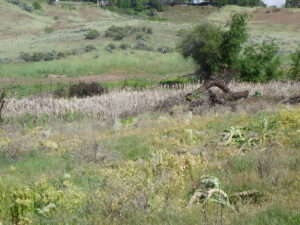
To the left, after emerging from the woodland portion of the path, is a major restoration project initiated with the removal of a large number of invasive Russian-olive trees (Elaeagnus angustifolia) in 2019. One immediate aftermath was an explosion of weeds, perhaps invigorated by nutrients that had built up under the dense thicket and/or released from the dying roots. On-going efforts include extensive planting of native shrubs, including interior rose and golden currant (Ribes aureum), and spraying of whitetop (Lepidium draba, previously in Cardaria), Scotch thistle (Onopordum acanthium), and other invasive non-natives.
Keep following Red-winged Blackbird Trail to its north terminus and then turn left on Chickadee Ridge Trail (#35A), which crosses a grassy swale before intersecting with Red Fox Trail. The primary grass in the swale is crested wheatgrass (Agropyron cristatum), a Eurasian species widely planted in the West in the name of range improvement. More prominent at this time of year are dense patches of a rapidly spreading annual, bur chervil (Anthriscus caucalis), which was scarcely present in the Boise area twenty years ago and is now increasingly ubiquitous. The primary native of interest here is smooth scouring-rush (Equisetum laevigatum), very different from the previously encountered common horsetail in having similar sterile and fertile stems, neither one with branches.
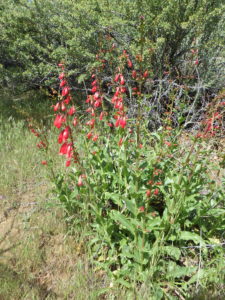
Turn left on Red Fox Trail and then keep an eye out for firecracker penstemon (Penstemon eatonii) in patches of bitterbrush on the right side of the path. The native range of this beautiful plant, with its bright red flowers, is in the central and southern Great Basin, occurring naturally no farther north than central Nevada and Utah. So, regrettably, firecracker penstemon does not qualify as native to the Boise area, but was instead intentionally introduced at some point (which is why Hulls Gulch might be the only place to see it growing in the wild locally). Fortunately it show no evidence of being anything other than a fine addition to the local botanical highlights, and is undoubtedly popular with hummingbirds as well.
Continuing south on Red Fox Trail past the junctions with the trails to 15th Street and Hulls Pond, take note of the sandy flat on the right side of the trail. In addition to the aptly-named needle-and-thread grass (Hesperostipa comata), one of the loveliest of our native grass, this is a good place to look for one of our special endemic plants, Mulford’s milkvetch (Astragalus mulfordiae). Stay on the trail while looking; if you want a close-up view, there are usually additional plants elsewhere along the trail ahead. Mulford’s milkvetch is named after Isabel Mulford (1848-1943), the first Ph.D. student at Washington University in St. Louis. Her collections in 1892, some made in the company of Mary Hallock Foote, are among the earliest from the Boise area. Mulford’s milkvetch, which grows only in the sandy foothills of southwestern Idaho and adjacent Oregon, is considered a sensitive species that has been a candidate for federal protection. Mulford’s milkvetch in the Boise Foothills has decreased by 83% compared to 2008, indicating that the conservation status of this unique plant is in jeopardy, at least locally (Mancuso & Brabec 2019). If you want to help with monitoring this and other rare plants, contact the Foothills Restoration Specialist for the Boise Parks and Recreation Department.
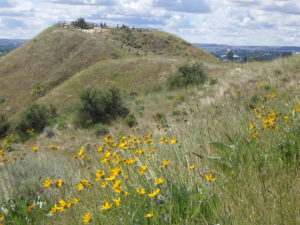
To continue with the self-guided tour, take a sharp right onto the Camel’s Back Trail network (#40), which will take you past a patch of pallid evening-primrose (Oenothera pallida). Then take the next sharp left, taking note of the green rabbitbrush (Chrysothamnus viscidiflora) with its twisted, bright-green leaves at the junction. Continue to the ridge, keeping an eye out for more Mulford’s milkvetch and neddle-and-thread grass in appropriate sites (unfortunately being increasingly overwhelmed by feral rye), as well as arrowleaf balsamroot (Balsamorhiza sagittata). Follow the ridge trail south to enjoy the view from the restored summit area, possibly timed to admire the sunset.
In early spring, there is a small colony of the rare Aase’s onion (Allium aaseae) tucked between the shrubs at the top of stairs on the south side of the the summit, but flowers and leaves are generally shriveled by mid-May; please avoid trampling off the path in this area. Instead, enjoy more pallid evening-primrose and the lavender-flowered silver phacelia (Phacelia hastata var. hastata) as you descend the stairs, along with some Indian ricegrass (Achnatherum hymenoides, previously in Oryzopsis). Turn left at the bottom of the stairs to return to the 9th Street Trailhead via Florence’s Trail. For one final ecological puzzle, speculate on possible reasons for the difference in vegetation between the uphill and downhill sides of the path, with the former still harboring native perennials while the latter is almost completely dominated by feral rye.
PLANT LIST [updating needed]
NOTE: Please enjoy the wildflowers and leave them for others to enjoy. Because our unique local flora is already under pressure from invasive weeds and habitat loss, harvesting of native plants is not encouraged on this website, especially along popular trails.
Plants likely to be in flower, weedy, or otherwise noteworthy are listed below, arranged alphabetically by current scientific name. NATIVE species in ALL CAPS.
- Box-elder (Acer negundo var. violaceum) – non-native tree; var. with finely hairy twigs is native in eastern Idaho but not locally
- YARROW (Achillea millefolium)
- Jointed goatgrass/strong>(Aegilops cylindrica) – invasive non-native
- Crested wheatgrass (Agropyron cristatum) – intentionally introduced non-native
- TAPERTIP ONION (Allium acuminatum)
- MOUNTAIN OR THINLEAF ALDER (Alnus incana ssp.. tenuifolia/incana) – small tree
- Desert alyssum(Alyssum desertorum) and/or pale alyssum (Alyssum alyssoides) – widespread non-natives, difficult to tell apart; also called madwort
- FIDDLENECK (Amsinckia spp.) – species difficult to distinguish
- Bur chervil (Anthriscus caucalis/scandicina) – recently established, rapidly spreading invasive non-native with hitch-hiking seeds
- Burdock (Arctium minus) – non-native, not yet in bloom
- BASIN BIG SAGEBRUSH (Artemisia tridentata ssp. tridentata)
- THREEAWN GRASS (Aristida purpurea var. longiseta)
- HERMIT MILKVETCH (Astragalus eremiticus)
- MULFORD’S MILKVETCH (Astragalus mulfordiae) – RARE SPECIES
- WOOLLY-POD MILKVETCH (Astragalus purshii var. glareosus)
- ARROWLEAF BALSAMROOT (Balsamorhiza sagittata)
- AMERICAN WINTERCRESS OR YELLOWROCKET (Barbarea orthoceras)
- SHINING, TALL, OR HOLLY-LEAVED OREGON-GRAPE (Berberis aquifolium [alternatively Mahonia]) – possibly escaped from cultivation locally
- WATER BIRCH (Betula occidentalis) – large shrub to small tree
- Cheatgrass (Bromus tectorum) – invasive non-native
- Corn gromwell (Buglossoides [previously Lithospermum] arvense) – non-native
- SAGEBRUSH MARIPOSA OR SEGO LILY (Calochortus macrocarpus) – probably not yet in bloom
- SEDGE(Carex sp.) – species difficult to distinguish
- Bachelor buttons, cornflower (Centaurea cyanus) – invasive non-native
- Rush skeletonweed (Chondrilla juncea) – invasive non-native
- GREEN RABBITBRUSH (Chrysothamnus viscidiflorus) – shrub
- ENCHANTER’S-NIGHTSHADE (Circaea alpina)
- Canada thistle (Cirsium arvense) – NOXIOUS WEED; not in bloom
- MINER’S LETTUCE (Claytonia/Montia perfoliata)
- Poison hemlock (Conium maculatum) – HIGHLY POISONOUS; noxious non-native
- RED-OSIER DOGWOOD (Cornus stolonifera s.l.)
- BLACK HAWTHORN (Crataegus douglasii) – large shrub to small tree
- WESTERN HAWKSBEARD (Crepis occidentalis)
- Flixweed, Herb sophia(Descurainia sophia) – weedy non-native
- Russian-olive (Elaeagnus angustifolia) – invasive non-native small tree
- SQUIRRELTAIL GRASS (Elymus elymoides, formerly Sitanion hystrix)
- RUBBER RABBITBRUSH (Ericameria [formerly Chrysothamnus] nauseosa) – larger var. hololeuca common on slopes, transitioning to smaller var. oreophila on plateau
- SHAGGY FLEABANE (Erigeron pumilus var. intermedius)
- Stork- or cranesbill, filaree (Erodium cicutarium) – non-native
- WESTERN GOLDENROD (Euthamia occidentalis [previously in Solidago]) – fall-blooming
- COMMON OR FIELD HORSETAIL (Equisetum arvense)
- SMOOTH SCOURING-RUSH (Equisetum laevigatum)
- CLEAVERS, BEDSTRAW, STICKYWILLY, GOOSE-GRASS (Galium aparine)
- LARGELEAF AVENS (Geum macrophyllum var. perincisum) – locally uncommon
- GUMWEED (Grindelia squarrosa)
- English ivy (Hedera helix) – non-native vine or ground-cover
- NEEDLE-AND-THREAD GRASS (Hesperostipa comata [previously Stipa])
- Mouse or wall barley (Hordeum murinum) – non-native invasive grass
- Juniper (Juniperus sp.) – bird-dispersed from cultivated plants
- Purple deadnettle or henbit (Lamium purpureum) – non-native
- Whitetop (Lepidium [previously Cardaria] draba) – NOXIOUS WEED
- European privet (Ligustrum vulgare) – non-native shrub
- NARROWLEAF OR GREAT BASIN BISCUITROOT (Lomatium simplex, previously included in L. triternatum, nine-leaf biscuitroot)
- Tatarian honeysuckle (Lonicera tatarica) – non-native shrub
- Purple loosestrife (Lythrum salicaria) – NOXIOUS WEED; fall-blooming
- Common mallow, cheeseweed (Malva neglecta) – weedy non-native
- Horehound (Marrubium vulgare) – non-native, not yet in bloom
- Pineappleweed (Matricaria discoidea [alternatively M. matricarioides, Chamomilla suaveolens])
- Yellow sweetclover (Melilotus officinalis) – invasive non-native
- FOOTHILL OR PEAK SAXIFRAGE (Micranthes/Saxifraga nidifica)
- Mouse-ear forget-me-knot, blue scorpion-grass (Myosotis micrantha/stricta) – non-native
- Watercress (Nasturtium officinale [previously Rorippa nasturtium-aquaticum]) – non-native
- Catnip (Nepeta cataria) – non-native, probably not yet in bloom
- Velvetweed or small-flowered gaura (Oenothera curtiflora, previously Gaura parviflora or G. mollis) – not native to Boise foothills, possibly in post-fire seeding; not in bloom
- HOOKER’S EVENING-PRIMROSE (Oenothera elata/hookeri) – possibly not yet in bloom
- PALE OR WHITE-STEMMED EVENING-PRIMROSE (Oenothera pallida)
- Scotch thistle (Onopordum acanthium) –NOXIOUS WEED
- Virginia creeper (Parthenocissus quinquefolia) – non-native vine
- Firecracker or Eaton’s penstemon (Penstemon eatonii) – native to Great Basin, intentionally introduced locally
- SILVERLEAF PHACELIA (Phacelia hastata)
- SYRINGA, LEWIS’S MOCKORANGE(Philadelphus lewisii)
- PRICKLYLEAF PHLOX (Phlox aculeata) intergrading with less compact LONGLEAF PHLOX(Phlox longifolia)
- WOOLLY PLANTAIN, INDIAN-WHEAT (Plantago patagonica)
- Bulbous bluegrass (Poa bulbosa) – invasive non-native
- SANDBERG BLUEGRASS (Poa secunda)
- BLACK COTTONWOOD (Populus trichocarpa) – other species and/or hybrids probably present
- NUTTALL’S OR SLENDER CINQUEFOIL(Potentilla gracilis var. fastigiata) – possibly not yet in bloom
- Cherry plum (Prunus cerasifera) – non-native tree; several other non-native Prunus also semi-established
- BLUEBUNCH WHEATGRASS (Pseudoroegneria spicata, alternatively in Agropyron or Elymus) – both native-to-site and planted races from other sites probably present
- BITTERBRUSH, ANTELOPE BRUSH (Purshia tridentata)
- BLISTER BUTTERCUP, CURSED CROWFOOT (Ranunculus sceleratus var. multifidus)
- GOLDEN CURRANT (Ribes aureum) – in fruit
- Black locust (Robinia pseudoacacia) – non-native tree
- Dog rose (Rosa canina) – non-native shrub with thick curved prickles, invasive in some spots
- Eglantine or sweetbriar rose (Rosa rubiginosa/eglanteria) – non-native shrub, similar to dog rose but with glandular foliage
- INTERIOR OR WOOD’S ROSE (Rosa woodsii subsp. ultramontana) – native, with slender prickles
- Himalayan blackberry (Rubus armeniacus/discolor/procerus) –invasive non-native with tasty berries
- Curlydock (Rumex crispus) – non-native
- WILLOWS (Salix spp.) – several species locally, most are difficult to distinguish except SANDBAR WILLOW (Salix exigua)
- Bouncingbet, soapwort (Saponaria officinalis) – non-native, probably not yet in bloom
- Tall fescue (Schedonorus arundinaceus [alternatively included in Fescue]) – non-native grass
- Cereal or feral rye (Secale cereale) – highly invasive non-native grass
- Tumble or Jim Hill mustard (Sisymbrium altissimum) – invasive non-native
- Climbing nightshade, bittersweet (Solanum dulcamara) – non-native vine, not yet in bloom
- GOLDENROD (Solidago sp.) – fall-blooming, species difficult to distinguish
- Tamarisk, salt-cedar (Tamarix parviflora) – invasive non-native shrub or small tree
- WESTERN POISON-IVY (Toxicodendron rydbergii, alternatively Rhus radicans) – CAUSES DERMATITIS
- Yellow salsify or goat’s-beard (Tragopogon dubius) – non-native
- Goat’s-head, puncture-vine (Tribulus terrestris) – NOXIOUS WEED; possibly not yet germinated
- WILD-HYACINTH, LARGE-FLOWERED TRITELEIA, OR DOUGLAS’S BRODIAEA (Triteleia grandiflora, previously Brodiaea douglasii)
- BROADLEAF CATTAIL (Typha latifolia)
- Siberian elm (Ulmus pumila) – non-native tree; other species and hybrids also present along stream
- STINGING NETTLE (Urtica dioica ssp. holosericea) – STINGING HAIRS; probably not yet in bloom
- Mullein (Verbascum thapsus) – non-native, not in bloom
- European cranberrybush (Viburnum opulus var. opulus) – non-native shrub
- Rattail fescue(Vulpia/Festuca myuros) – non-native grass
